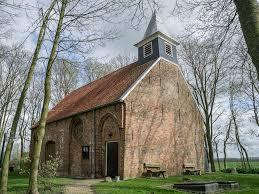Monastery Chapek

This one-aisled church was built around 1300 in Romano style, presumably as a chapel of the neighboring state, now a farm. In the choir of the church is the burial cellar of the Tjaerda family of Starkenborch.
About this building
Around the church, which is all alone on a mound, there are only a few houses and farms in the middle of the clay landscape above Dokkum. The graveyard, which surrounds the church, is itself surrounded by a moat. The church lies under tall trees on a mound. In the north wall there is a now closed romanogothic window and a round window in a niche that runs to the ground. The entrance is located on the south side. The Kloosterkapel is equipped with a simple roof turret. In the choir there is a cabinet organ, next to the pulpit. The Kloosterkapel has been known for 20 years in the surrounding area because of the many well-attended concerts of Frisian troubadours, folk groups, classical ensembles and senior orchestras. A kitchen and toilet have been installed in the church. The Kloosterkapel is available to rent for weddings, funeral services and (family) meetings and is also very suitable for making sound recordings (as the Frisian pop group De Kast has proven). Once a year a church service is held in the Groninger language, for Groningers from the province of Frysin.


